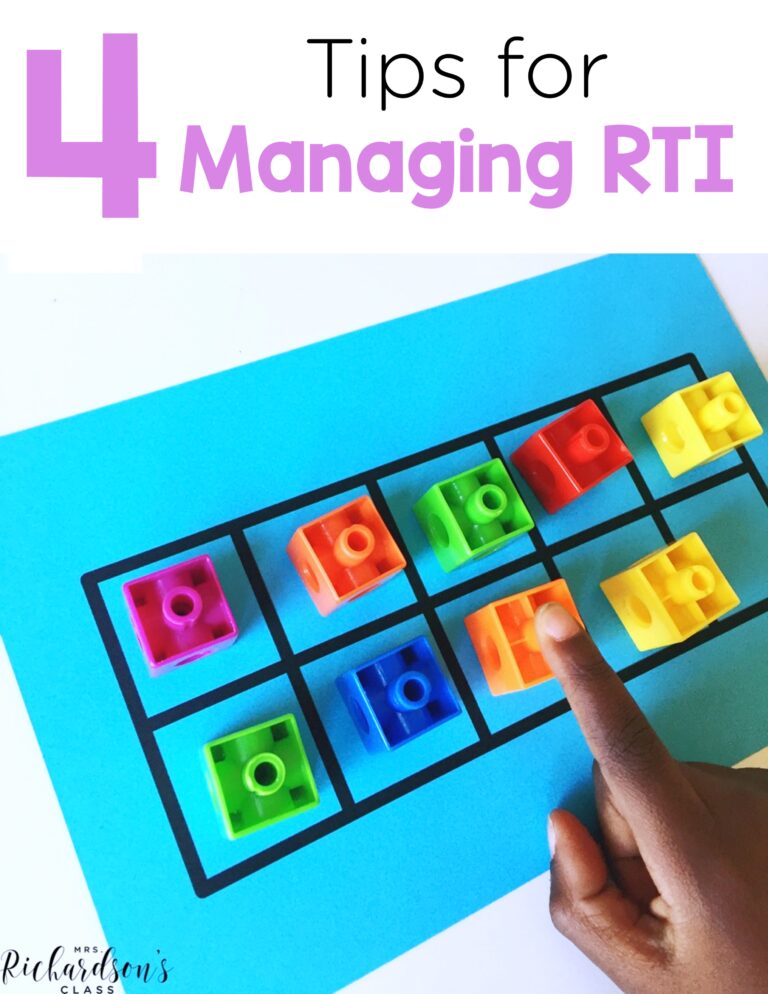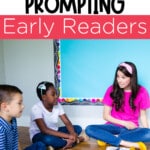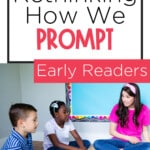


You are sitting at the guided reading table and a child gets to a word and is staring blankly at you. You aren’t quite sure why they don’t know that word. You know the child can monitor for meaning as they are reading. You know the child has seen the word before. But you see the child freeze. They are stuck. When it comes to prompting early readers, what do you do when they are stuck?
I have a solid background in balanced literacy training. For years I have looked to many trusted sources as I have grown and developed in my literacy instruction. Now, I’m not ready to say “throw it all away”, but I am ready to say, “It’s time to make some changes.”
For years I was taught, shown, and even taught others that one of the first ways we can prompt our early readers is to say, “look at the picture.” I even created decoding strategy posters to help remind our readers of several of these strategies. We often are so worried that kids will miss out on meaning, which we all know is the point of reading, that we are not giving all the parts of the cueing system equal time as we should. We are first attending to meaning, then visual and syntax.
But friends, as more and more research is surfacing on how our brains really work to learn the reading code and how we really need to help kids have long-term success with reading, this is not the first way we need to prompt kids.
It’s time to make a change. It’s time for us to change how we are prompting our early readers. We want them to FIRST attend to the text. We want visual to be the first cueing system they use.
We want them to sound it out. We want them to decode the word the best that they can.
Then, we want them to use meaning and syntax to cross-check. This is not always a one-and-done thing. They may sound it out, cross-check, go back to the word and sound it out, then cross-check again before they land on a word that is correct.
It’s time to rethink how we are prompting early readers. If you are looking for some visual reminders, I have new decoding strategy posters that align with The Science of Reading and help our kids attend first to the text.
Grab the FREE Decoding Strategy Posters here.
Sometimes kids can feel discouraged when books have several tricky words that they are unable to decode. This is why using decodable texts in guided reading groups is a great method to help give kids authentic practice on a level that is not frustrational for them.
If you are looking for decodable texts for your early readers, we are working tirelessly to get some in your hands as soon as possible! Be sure to join the waitlist so that you know when
If you found this information rocked your boat a little, you are in good company, friend! We have all been there. We are all learning and growing together! I’d love to know what new literacy learning is rocking your boat! Leave me a comment below!

Want to use the latest research to boost your readers during small groups? This FREE guide is packed with engaging ideas to help them grow!

I’m a K-1 teacher who is passionate about making lessons your students love and that are easy to implement for teachers. Helping teachers like you navigate their way through their literacy block brings me great joy. I am a lifelong learner who loves staying on top of current literacy learning and practices. Here, you’ll find the tools you need to move your K-2 students forward!


| Cookie | Duration | Description |
|---|---|---|
| cookielawinfo-checkbox-analytics | 11 months | This cookie is set by GDPR Cookie Consent plugin. The cookie is used to store the user consent for the cookies in the category "Analytics". |
| cookielawinfo-checkbox-functional | 11 months | The cookie is set by GDPR cookie consent to record the user consent for the cookies in the category "Functional". |
| cookielawinfo-checkbox-necessary | 11 months | This cookie is set by GDPR Cookie Consent plugin. The cookies is used to store the user consent for the cookies in the category "Necessary". |
| cookielawinfo-checkbox-others | 11 months | This cookie is set by GDPR Cookie Consent plugin. The cookie is used to store the user consent for the cookies in the category "Other. |
| cookielawinfo-checkbox-performance | 11 months | This cookie is set by GDPR Cookie Consent plugin. The cookie is used to store the user consent for the cookies in the category "Performance". |
| viewed_cookie_policy | 11 months | The cookie is set by the GDPR Cookie Consent plugin and is used to store whether or not user has consented to the use of cookies. It does not store any personal data. |




3 Responses
Wondering if the one that says say every sound should have them scan the word first and find parts of the word that can help them. th, sh, ar, ing, etc. We don’t want them going letter by letter if they don’t need to. Highlighter tape is wonderful to help them see the tricky part of a word or to remind them that some combos make new sounds. Just a thought.
Also to say the sounds so they ‘touch’ each other instead of isolated sounds that they can’t keep track of to then say the sentence.
Hi Amanda!
Thank you for revising and sharing your reading strategy posters. I have been moved down to first grade this year and wanted something to go along with the science of reading training we are doing that is also kid friendly. Your posters were the perfect fit. I can’t wait to use them with my kiddos this year!
I’m so glad you love them!! I hope you enjoy your year in 1st grade! It’s a fun age to teach!!